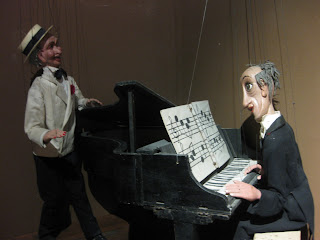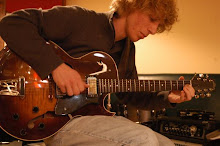I woke up by 3:30AM on the first morning in Italy. I tried my best to fall back asleep, but after ninety minutes of lying awake in bed, I decided to get up and write in my journal until breakfast began around 7:00.
I'd forgotten; breakfast in Italy is not the same as in America, as lunch is the big meal of the day here. Breakfast is a small bite to eat—pastry and coffee—just to hold you over until lunch.
It wasn't until 9:00 that the whole class met in the lobby to leave for the day's activities. We were off to the nearby town of Monreale (Royal Mount) where the Palermo province's famous cathedral stands.
Cacti outside the parking lot in Monreale
Entering the town town of Monreale
The Monreale town center
I feel like I've seen enough of these Catholic churches in Europe to have them not stand out so much anymore. They really are all so amazing, but our destination remained awe-inspiring. The cathedral sat well up on the hillside to the south of Palermo, offering wonderful views of the city and it's valley, often referred to as "the conch" because it resembles a shell. The church itself was laden with gold and silver plated tile mosaics representing the stories of genesis in comic-book style frames circling the nave. The mosaics brought real recognition to this cathedral, which also featured interesting Arab—both Islamic and Sephardic—insignia lower on the walls, representing the island's diverse heritage of inhabitants. Apparently the church was built after the Norman invasion of the 11th Century, and they realized the best way to profit off of the island was to encourage the cooperation of the existing residents and perpetuating the strong port, even if it meant compromising some of the Christian values espoused by the Normans and their Holy Roman Empire support.
Of course the Jewish population was later wiped out when Spain had control during the inquisition. Jackie, our tour guide, said that most people in Sicily with explicitly Christian last names were descendants of Jews who'd changed their names during the inquisition.

Inside the Monreale Cathedral
Here you can see the stories of Adam & Eve (top) and Esau & Jacob (below) in the mosaic scenesLooking at the ceiling from behind the organ
More exciting than the inside of the cathedral was climbing to the top of the building to see the view overlooking "the conch."
The roof of a chapel on the way up to the top of the cathedral
The cloister adjacent to the cathedral
The bell tower and chapel seen from a window in the passage up to the top of the cathedral
The basically two-way passage that can only fit people going one direction
Nearing the top
At the top!
Pizeme, one of my fellow classmates, walking just below the tower.
Looking out across "the conch" towards Palermo and the sea.
A fountain in the town center of Monreale outside the cathedral
A nice little park adjacent to the cathedral with some giant fig trees. One of these giant fig trees in Palermo is the largest tree in Europe in terms of area.
Before returning to Italy, I contacted two of my former professors in Florence to see if they had any recommendations on things to see and do in the area of Palermo, and they both made a point of highlighting the Cathedral of Monreale. It didn't take too long for me to figure out—based also on our class's itinerary which was nearly all outside of Palermo—that there wasn't a lot to see in that big city. It is the modern urban hub of western Sicily, but the island's true treasures lay in the countryside.
With that said, we returned to Palermo to tour a small street market, a historic remnant of the Phoenician (Carthaginian-Arab) presence on the island. Compared to the remarkable Boqueria in Barcelona or even Mercato Centrale in Florence, I felt a bit underwhelmed by the displays. It wasn't the most photogenic place, but certain products like cauliflower looked so fresh and tasty. The key difference between Sicilian market and the others I'd seen in Europe is the greater Arab influence in Sicily. The Arabs were proponents of outdoor displays of their local products in the open air on pedestrian streets. In other European cities, these markets tend to be sheltered in buildings.
A building at the entrance to the street market
There was lots of fresh fish on display, though nothing quite as exciting as the Monkfish of Barcelona.
Broccoli (which actually means cauliflower here.)
Fresh produce
In a restaurant adjacent to the market we had our lunch, which came out in a quick succession of courses. The meal featured caponata, cornmeal and ricotta stuffed eggplants, a round hoop-like pasta with prosciutto and hard-boiled egg-white baked in tomato sauce, and finally a local ricotta-stuffed cake called cassata.
By this time I was starting to feel the effects of my minimal sleep, but it was off to the puppet museum, representing the island's long history of marionettes. The medium was a predecessor to television, with serialized shows, which local residents would come back for each week. The museum housed the largest collection of puppets in the world: more than 4000 in all.

At the puppet museum

Unfortunately we weren't able to see a show. It seems the art form is now dead, and this is here for tourist season when they can do more demonstrations.
This was an advertisement for a puppet show, basically saying, "next week on..."
By this time, I first began to detect Jackie's penchant for telling the history of her homeland with a heavy dose of pride. Underlying everything she says there appears to be this sentiment that Sicily has gotten a bad rap through the years, and she would like to change those perceptions one tour group at a time. This is a position I often feel myself when talking about Philadelphia to those from elsewhere, but the way she communicates is a bit heavy-handed. For better or worse, I feel like I'm getting a more biased and purposefully propagandized version of the facts relating to the history and accomplishments of the island and its people.
She would many times tell us about how, even though the Italian courts ruled in favor of Naples, all Sicilians know that they invented pizza first. Similarly, she would discuss more pointedly how northern Italians are the more ignorant people with racial stereotypes for the south. According to her, there is no outward racism or homophobia, even though she herself told us that if her gay friends were to come out publicly they would lose their jobs.
One particularly interesting remark I found was that Sicilians refer to northerners as polenta eaters versus the south where people eat more (and obviously created) pasta. With this in mind, she then told us that polenta is cornmeal, a simple grain, whereas pasta is seen as more of a delicacy. I couldn't help but think that, wheat is just a grain too, but if anything, I would only come to appreciate these comments as an interesting view into the biased perspective on history she takes.
After the museum, I got to take a nice nap at the hotel, and I went out on the town again that evening with a group of about eight people in my class. We ended up at a local Neapolitan-style pizzeria that was quite good. I went for the Italian staple: quattro stagioni, featuring artichoke (carciofi) and prosciutto. Life in Italy is looking pretty good!
Gates at the Palermo port






























No comments:
Post a Comment